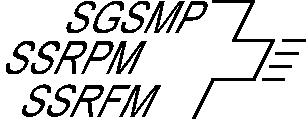
| Inhaltsverzeichnis (list of contents) EQUAL-ESTRO ------------- andere Bulletins / d'autres bulletins / altri bolletini / other bulletins |
ESTRO has recently
set-up a quality assurance network with the acronym EQUAL
(ESTRO QUality
Assurance Link). The measuring centre is
located within the Physics Department of the Institut
Gustave Roussy in Villejuif headed by Prof. J. Chavaudra.
The ESTRO staff consists of a physicist, a technician and
a secretary. The measurements have already started and
during this year it is intended to carry out a postal
dosimetry check for about 200 centres. The purpose of the
audit is to check the dosimetry data of radiation therapy
treatment units by checking: A maximum of 3 beams per centre is checked. The check comprises irradiating dosemeters (LiF capsules in the well known IAEA holder placed in a water phantom) to a specified dose, which should be calculated as in clinical practice. The service is free of charge for 1998 in the first instance (note added later : also free of charge in 1999). It is open to all ESTRO members, but is intended mainly for centres in Europe in the initial phase of the project. The TLD laboratory can be contacted directly by fax or phone or E-mail. When contacted, the TLD laboratory sends a questionnaire to the centre for information on treatment unit paramenters to be checked. This must be returned to the TLD laboratory before a date can be fixed for the measurements. For those of us who have not done so yet, I would recommend that you to participate in this study especially as it would give us an excellent opportunity to compare these results with those of our own annual audit. In fact, this service has proved so popular that the TLD laboratory has been overwhelmed with requests for measurements, which is a good thing because it has made people more aware of the necessity for quality assurance. It is clear that this service could be expanded to a more comprehensive check of machine parameters. For instance, it is conceivable that a multi-purpose phantom could be used for the measurements and thus provide a check of other treatment parameters at the same time. Collaboration with other institutes could also be envisaged, for example with the Network of European Centres (which is a QA network partly financed by the European Community and organized by the RT-Physics group in Leuven) or the EORTC Quality Assurance Programme, although the main aims and target groups of these QA programmes may not be the same. We should, as a society, decide whether or not to endorse such a programme for our own QA even at a cost, instead of making a solitary effort, bearing in mind that EQUAL has the benefit of better statistics and greater experience in TLD manipulations. Also it would be desirable to compare our results with those of the rest of Europe. The advantage of our present system is that it is free of charge to the users (a word of thanks here for the SAKK for their financial help and for Prof. Lütolf for his support in terms of personnel and use of infrastructure) and it is informal, which encourages the small centres to participate. The ESTRO programme is presently free of charge too (note added later : also free of charge in 1999) but how expensive it will prove to be in the future remains to be seen. If we decide to continue with the present system, the programme will need to be expanded as the measurent of dose at a reference point only is not adequate. We should at least consider the use of a multi-purpose phantom for future measurements. Bernard Davis (Zürich) |
| top of page | Diese
Seite wird von Wolf Seelentag betreut (Text von Bernard
Davis), letzte Bearbeitung 13 September 2011. Senden Sie Kommentare und/oder Ergänzungen bitte an den Webmaster SGSMP. |